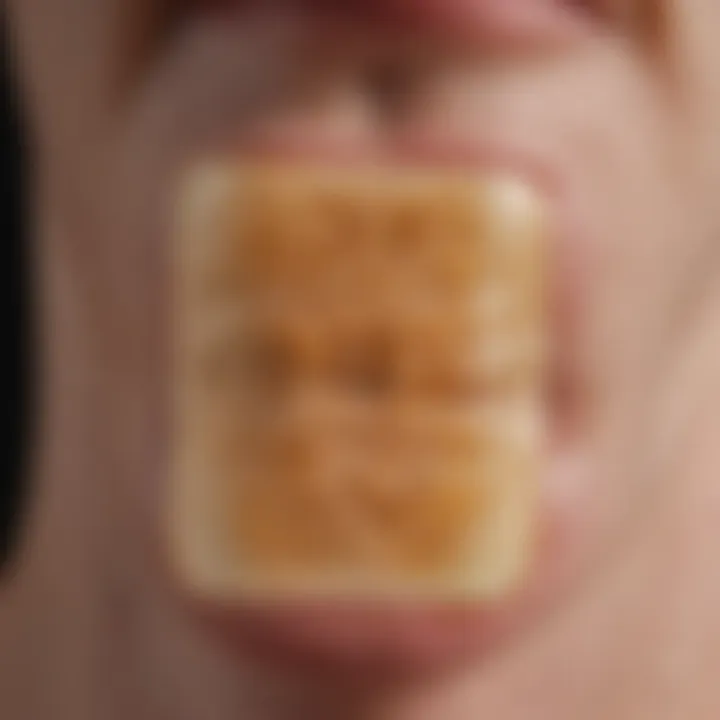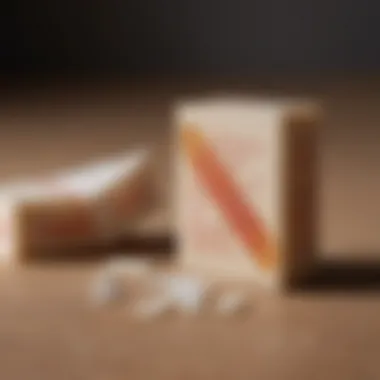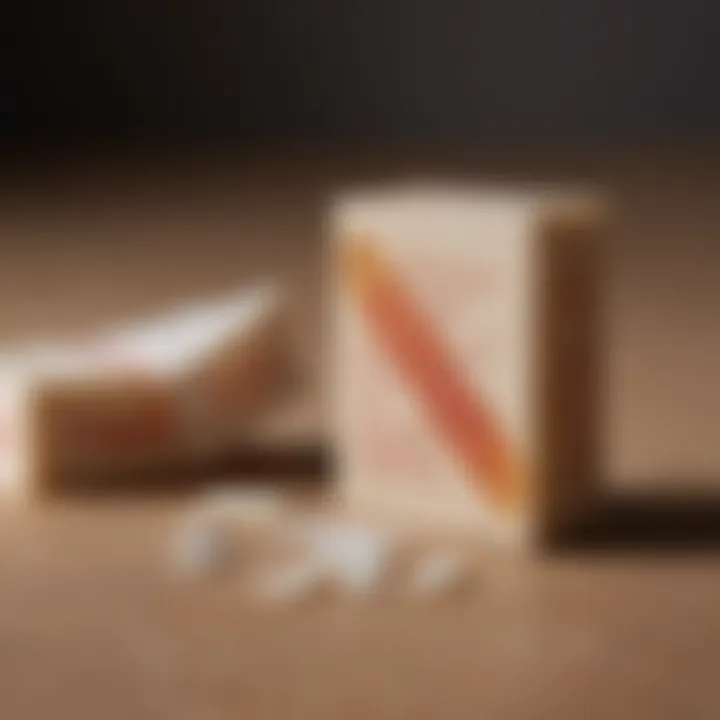Understanding Band-Aids for Burn Injuries


Intro
Burn injuries are a common occurrence, ranging from minor kitchen mishaps to more severe industrial incidents. How one treats these injuries can significantly influence recovery outcomes. A frequent question that arises is whether using Band-Aids, or adhesive dressings in general, is appropriate for managing burns. Understanding the implications of this practice can guide patients and caregivers in making informed decisions about burn care.
This article will explore the effectiveness of Band-Aids on burn injuries, consider alternative treatments, outline the potential risks involved, and provide best practices for wound management. By examining the physiological response to burns and the composition of Band-Aids, we aim to equip readers with valuable insights relevant to burn care strategies.
Methodology
This article employs a combination of literature review and analysis. We looked at peer-reviewed studies, clinical guidelines, and expert opinions to present a thorough understanding of the subject.
Overview of research methods used
Research focused on various case studies detailing the application of Band-Aids on burn injuries. By reviewing clinical data and patient outcomes, we gathered insights into how these dressings perform in real-world scenarios.
Data collection techniques
Data was mainly sourced from academic journals and reliable health websites. The information gathered was then analyzed to identify trends, effectiveness, and safety issues concerning the use of Band-Aids for burn treatment.
Key Considerations for Using Band-Aids on Burn Injuries
When considering the application of Band-Aids on burn injuries, a few key points deserve attention:
- Type of burn: Different severities of burns require distinct treatment approaches. Minor burns may benefit from basic adhesive bandages, while more severe burns might not.
- Wound condition: If the burn has blisters or is weeping, a Band-Aid could cause further irritation or lead to infection.
- Material composition: The materials used in Band-Aids can dictate how well they adhere and protect the wound. Some may adhere too tightly, making removal painful.
"The appropriate treatment for burn injuries often hinges on an understanding of wound characteristics and patient needs."
Future Directions
Upcoming trends in research
Ongoing studies are examining the effectiveness of advanced wound dressings designed specifically for burn injuries. Innovations in materials may provide better outcomes than traditional Band-Aids.
Areas requiring further investigation
While we have gathered relevant information, further studies are necessary to explore the long-term effects of adhesive dressings on burn healing. Understanding the patient experience and preferences in dressing choices could also promote better care strategies.
Preface to Burn Injuries
Burn injuries are significant medical concerns that can lead to various complications if not properly managed. Understanding burn injuries is essential for effective treatment and prevention of further damage. The use of Band-Aids for burn care, while common, has specific implications that need to be assessed. This section lays the groundwork for analyzing the proper care necessary after sustaining a burn.
Definition of Burn Injuries
A burn injury is defined as damage to the skin or other tissues caused by heat, chemicals, electricity, or radiation. It disrupts the normal structure and function of the skin, leading to pain, swelling, and sometimes severe complications. Accurate identification and classification of burns are important steps toward effective treatment. Any misconceptions about burns can result in inadequate care and long-lasting consequences, making education vital.
Types of Burns
Thermal Burns
Thermal burns occur when the skin comes in contact with hot objects, flames, or steam. The high temperatures cause instant damage to skin tissues. The significance of thermal burns lies in their prevalence. They are often due to mishaps in kitchens or during recreational activities. One key characteristic of thermal burns is that they can range from minor to severe, depending on the temperature and duration of the exposure. While minor thermal burns can heal relatively quickly, severe cases may require extensive medical intervention.
Chemical Burns
Chemical burns result from exposure to corrosive substances, such as acids or alkalis. The impact of chemical burns can be more devastating than thermal burns because they may not cause immediate pain, leading to delayed treatment. They may affect deeper layers of skin, making early identification and proper treatment critical. The unique aspect of chemical burns is the potential for continued damage until the substance is neutralized or removed. Mismanagement can lead to serious complications.
Electrical Burns
Electrical burns arise from electrical currents passing through the body. The real danger lies not only in the visible damage but also in possible internal injuries. This type of burn may not always have external signs, making it deceptive. Due to their complexity, electrical burns require careful assessment and specialized treatment. Their key characteristic is the different mechanisms of injury, which can lead to heart problems or other systemic issues requiring immediate medical attention.
Radiation Burns
Radiation burns result from exposure to radioactive materials or prolonged exposure to UV radiation from the sun or tanning beds. While often seen as less critical than other burn types, radiation burns can have severe long-term effects. Their unique feature is delayed onset, leading to misjudgment about the seriousness of the injury. Understanding radiation burns promotes more effective prevention measures, especially for individuals with occupational exposure.


Burn Severity Classification
First-Degree Burns
First-degree burns are the mildest type, affecting only the outer layer of skin. They appear red, dry, and painful but typically heal without medical intervention. Their key characteristic is rapid recovery, often within a week. These burns provide insight into proper home care practices for minor injuries, demonstrating the role of self-treatment in minor burn care.
Second-Degree Burns
Second-degree burns affect both the outer and underlying layer of skin. They result in blisters, extreme pain, and swelling. The recovery time is longer compared to first-degree burns, often requiring several weeks. Their importance lies in the risk of infection and scarring, emphasizing the need for proper medical assessment and attention. Such burns show that not all injuries can be managed at home, leading toward understanding complications in treatment.
Third-Degree Burns
Third-degree burns are the most severe, destroying all layers of skin and potentially affecting underlying tissues. The skin may appear charred or leathery, and the patient often experiences numbness due to nerve damage. Their key characteristic is the requirement for advanced medical intervention, often necessitating surgery or skin grafts. This severity underscores the critical nature of rapid assessment and referral to specialized care, crucial for successful recovery and rehabilitation.
Overview of Band-Aid Technology
Understanding Band-Aid technology is essential when assessing their application in treating burn injuries. Band-Aids serve as a convenient, ready-to-use option for wound care. Their design and components are crucial in ensuring proper protection and support during healing. Knowing how these adhesive dressings work helps individuals to make more informed decisions regarding their use on burn injuries.
Composition of Band-Aids
Adhesive Materials
The adhesive materials in Band-Aids play a primary role in their functionality. These materials create the crucial bond between the dressing and the skin. Commonly, latex-free acrylic adhesives are favored for their effectiveness and hypoallergenic properties, reducing the risk of irritation. These adhesives are also flexible, allowing the Band-Aid to move with the skin while maintaining adhesion. While beneficial for most minor wounds, they may not always adhere well to moist or weeping surfaces, which can be a disadvantage when dealing with certain types of burns.
Absorbent Pads
Absorbent pads are another key element in Band-Aid design. They are formulated to manage exudate, which is important in preventing moisture buildup around a wound. This property is valuable as it promotes an optimal healing environment, minimizing the risk of infection. The unique feature of these pads is their ability to draw fluid away from the burn while remaining non-stick to the injury site. However, they may become saturated quickly if the burn exudes a lot of fluid, necessitating more frequent changes.
Backing Layers
Backing layers provide structural support for the Band-Aid and protect the wound from external contaminants. These layers are often made from flexible, breathable materials that keep the wound covered while allowing air to reach it. This balance is essential for healing. While backing layers are generally effective, they can sometimes lead to increased moisture trapped underneath if not designed properly. This moisture may become a breeding ground for bacteria, hence emphasizing the need for appropriate selection and usage based on burn severity.
Intended Uses of Band-Aids
Minor Cuts
Band-Aids are most commonly associated with treating minor cuts. Their ability to provide a protective barrier, without causing undue pain during application, makes them a popular choice. They cover and shield the wound from dirt and bacteria, reducing infection risks. The downside is that Band-Aids are not suitable for deeper cuts or those that require medical evaluation, which can lead to complications if misused.
Scrapes
For scrapes, Band-Aids serve a similar function as with minor cuts. They protect the area while allowing it to heal naturally. Many scrapes occur in environments where dirt and bacteria are prevalent, highlighting the need for a protective cover. However, like with cuts, deeper scrapes may require more specialized care to ensure proper healing and prevention of infection.
Burns
Using Band-Aids on burns is controversial. While they may provide a barrier against infection, they are typically not designed for serious burn care. Their use should be limited to milder burns—such as first-degree burns—where they can support healing by retaining moisture. For second or third-degree burns, more specialized dressings are recommended to manage fluid, pain, and promote healing, making Band-Aids less appropriate in such cases.
In essence, while Band-Aids can serve specific roles in wound management, particularly for minor injuries, judicious use is critical for more serious ailments like burns.
By considering the composition and intended uses of Band-Aids, individuals can better inform their choices regarding burn treatment.
The Rationale Behind Using Band-Aids on Burns
The application of Band-Aids on burn injuries raises significant discussions surrounding their efficacy and appropriateness. Understanding the rationale behind this practice is crucial for patients and caregivers alike, who seek effective methods for managing burn wounds. Band-Aids serve several functions when applied to burns, and each function contributes to patient recovery. In this section, we explore key elements like the protective barrier they provide, moisture retention capabilities, and potential for pain relief.
Protective Barrier
One primary advantage of using Band-Aids on burn injuries is the protection they offer. When a burn occurs, the skin barrier is compromised, exposing the underlying tissue to environmental contaminants, such as dirt and bacteria. Band-Aids can create a physical barrier that helps shield the injured area from these external threats. This barrier is essential in preventing infection, which could lead to more severe health complications.
It's also important to note that not all bandages are suitable for burn treatment. The adhesive and material should be selected carefully to prevent further irritation or damage to the already sensitive area. An appropriate bandage will facilitate healing without causing additional pain to the patient.
Moisture Retention


Another significant benefit of applying Band-Aids on burns is moisture retention. Maintaining a moist environment is often considered beneficial for wound healing processes. Band-Aids with specific absorbent pads can help retain the naturally occurring moisture in the wound. This moisture can promote faster epithelialization, reducing the overall healing time. A dry wound tends to form scabs, which may lead to a longer recovery period and unwanted scarring.
When using Band-Aids for burn injuries, it is vital to change the dressing regularly to ensure the wound remains adequately moist and prevent accumulation of exudate.
Pain Relief
Pain management is a critical factor when it comes to burn care. Band-Aids can offer some degree of pain relief. The pressure and cushioning provided by the product can reduce pain levels by protecting the wound from sudden movements or external irritants. Additionally, certain modern Band-Aids are designed with a cooling gel or other pain-relieving agents that can offer aspects of analgesia.
While Band-Aids have these potential benefits, it is also essential to consider when they might not be appropriate for burn care. Deep burns or extensive surface area burns may require more advanced medical treatments. In such cases, consulting a healthcare professional is recommended.
Band-Aids can play an important role in the initial management of minor burn injuries, yet understanding their limitations ensures informed decision-making.
Potential Risks and Complications
Understanding the potential risks and complications associated with using Band-Aids on burn injuries is essential. While these adhesive dressings can provide a temporary solution, they may also lead to several issues that warrant careful consideration.
Infection Risks
Burns are inherently vulnerable to infection due to the compromised skin barrier. When a Band-Aid is applied to a burn, it can trap moisture and create a warm environment conducive to bacterial growth.
Notable risk factors include:
- Inadequate cleaning of the wound: If the burn is not properly cleansed before application, residual dirt can lead to an infection.
- Prolonged use: Keeping a Band-Aid on for too long without changing it can escalate infection risk.
- Size of the Band-Aid: If the dressing does not adequately cover the burn, exposure to contaminants increases.
Infections can exacerbate the healing process and may require medical intervention, emphasizing the need for awareness and adequate care.
Allergic Reactions to Adhesives
Another concern is the potential for allergic reactions to the adhesive materials used in Band-Aids. Some individuals may experience skin irritation, rashes, or other allergic responses. Not all Band-Aids are created equal; some contain latex or other compounds that could trigger sensitivities. Symptoms to watch out for include:
- Redness or swelling near the application site.
- Itching or burning sensations.
- Severe reactions: In rare cases, a more serious allergic reaction could occur, necessitating immediate medical attention.
It is advisable for individuals to perform a patch test with a small piece of the adhesive on healthy skin, especially if they have a history of skin allergies.
Impeded Healing Processes
Finally, the use of Band-Aids on burn injuries can impede the natural healing processes. Band-Aids may not adequately allow airflow to the wound, which is vital for regeneration of the skin. The moisture retained under a Band-Aid might create a soft, macerated wound bed, hampering recovery. Key considerations include:
- Moisture balance: While some moisture is necessary, excessive moisture can delay healing.
- Contracture: If the Band-Aid restricts movement too much, it may cause scarring and contracture, limiting skin elasticity.
- Monitoring changes: Any signs of worsening condition, such as increased pain or discoloration, should prompt a change in care strategy.
Effective management of burn injuries requires not only proper application but also keen observation of the healing process.
Alternative Treatments for Burn Care
The exploration of alternative treatments for burn care is crucial for understanding the various options available beyond standard adhesive dressings like Band-Aids. While Band-Aids may offer basic protection, burn injuries often require specialized care to promote healing, manage pain, and reduce scarring. In this section, we will discuss effective alternatives that provide numerous benefits for burn management, particularly focusing on hydrogel dressings, silicone gel sheets, and medical-grade burn ointments.
Hydrogel Dressings
Hydrogel dressings are a sophisticated option for burn treatment. They consist mainly of water and are designed to maintain a moist environment around the burn wound. This moisture is essential for promoting optimal healing and cell regeneration. Unlike traditional dressings that may stick to the wound and cause further pain upon removal, hydrogel dressings are gentle on the skin. They offer the following benefits:
- Moisture Retention: This dressing keeps the wound site hydrated, which is especially important for second-degree burns.
- Cooling Effect: Hydrogel provides a soothing effect, helping to alleviate pain and discomfort.
- Reduced Risk of Infection: By forming a barrier, hydrogel dressings can prevent external contaminants from entering the wound.
Silicone Gel Sheets
Silicone gel sheets are another effective alternative for burn care. These sheets are used primarily for scar management following the initial healing of burn injuries. However, they can also be beneficial during the healing phase. The primary advantages include:
- Scar Prevention: Silicone has been shown to reduce hypertrophic scars, which can develop following burn injuries.
- Flexibility: These sheets conform to the skin and are suitable for various body areas, even those that are more mobile.
- Ease of Use: Patients can easily apply and remove silicone sheets without causing additional pain, making them patient-friendly.
Medical-Grade Burn Ointments
Medical-grade burn ointments are specifically formulated to aid in the healing process of burn wounds. These ointments often contain ingredients that promote healing, reduce inflammation, and prevent infection. Key factors about these ointments include:
- Healing Agents: Some ointments contain silver sulfadiazine, which is effective against bacteria, while others may have aloe vera for soothing effects.
- Moisturization: These ointments help to keep the wound moist, further supporting the healing environment.
- Application Considerations: It is critical to follow the directions for use, as applying too much can lead to complications.


Ultimately, each of these alternative treatments presents distinct advantages that cater to specific needs in burn care. Assessing the type and severity of the burn, as well as individual patient requirements, is vital in choosing the most appropriate treatment option.
Guidelines for Proper Burn Care
Proper burn care is essential to facilitate effective healing and prevent complications. Understanding how to manage burn injuries adequately can make a significant difference in recovery. Inadequate care can lead to infections and prolonged healing times. Thus, having a clear set of guidelines and following them can not only improve patient outcomes but also provide peace of mind to caregivers.
Initial Assessment of the Burn
The first step in burn management is a thorough assessment. This step determines the severity of the burn and helps guide treatment decisions. When assessing a burn, consider the following criteria:
- Location: Burns on the face, hands, feet, or genitals often require more careful consideration.
- Depth: Understanding whether a burn is first, second, or third degree informs the urgency of care needed.
- Size: Larger burns may require specialized medical intervention.
Identifying these factors accurately is critical. It shapes not only immediate treatment but also potential referral to a healthcare professional if necessary.
Cleaning the Burn Wound
After initial assessment, the next proper step is to clean the burn wound. This process helps eliminate debris and reduces the risk of infection. Here’s how to approach it:
- Wash Hands: Always ensure that your hands are clean to avoid introducing bacteria.
- Rinse the Burn: Use cool (not cold) water to gently rinse the area for 10 to 20 minutes. This action can minimize pain and heat damage.
- Avoid Harsh Products: Soap and alcohol can irritate the burn, so it is advisable to use only clean water.
Gentle cleaning prepares the wound for any dressing and promotes a conducive environment for healing.
Selecting the Right Dressing
Choosing the appropriate dressing is vital in managing burns effectively. Various types of dressings serve different purposes. When selecting a dressing, consider these points:
- Burn Severity: For minor burns, over-the-counter hydrocolloid dressings may suffice. However, for more severe burns, specialized dressings might be necessary.
- Moisture Control: A dressing that maintains moisture helps promote healing. Consider using silicone-based or hydrogel dressings in such cases.
- Adhesive Properties: Ensure that the adhesive used is gentle enough for sensitive skin. Allergic reactions to adhesives can exacerbate the healing process.
Choosing the right dressing is not a trivial decision. An appropriate dressing can almost entirely dictate the healing trajectory of the burn.
When to Seek Medical Attention
Burns can vary significantly in terms of severity and implication for health. Identifying when to seek medical assistance is crucial, as prompt care can prevent complications, promote healing, and minimize discomfort. Understanding the thresholds for medical attention can empower individuals to make timely decisions, which is especially necessary when dealing with burn injuries.
Signs of Infection
When caring for burn injuries, it is critical to monitor for signs of infection. Infection can complicate the healing process, and early detection is vital. Here are some common indicators that may suggest an infection:
- Increased redness around the burn area.
- Swelling that appears to worsen over time.
- Pus or discharge, especially if it has a foul odor.
- Fever or chills accompanying the burn injury.
- Persistent pain that escalates rather than diminishes.
If any of these signs appear, seeking medical advice is necessary. In cases where infection is suspected, healthcare providers may recommend treatments that could include antibiotics or advanced wound care methods.
Advice for Severe Burns
Severe burns require immediate medical intervention. Recognition of a serious burn is essential. The following characteristics generally indicate that professional help should be sought:
- Burns covering a large area, such as the torso or limbs.
- Burns involving the face, hands, feet, groin, or major joints.
- Third-degree burns that appear charred, white, or leathery.
- Burns caused by chemicals or electricity that may have deeper tissue damage.
For severe burns, it is critical to avoid home remedies or over-the-counter treatments. Instead, prioritize immediate transport to a medical facility. Emergency medical staff can provide specialized care, including potential skin grafts or other surgical interventions. In the interim, cover the burn with a clean, dry cloth to protect the area and avoid exposure to contaminants.
Prompt medical attention is indispensable for survival and recovery in cases of severe burns.
Realizing the need to contact medical professionals can be lifesaving. Burn injuries may not always present their full extent immediately, making vigilance and caution fundamental practices in burn care.
Closure
In this article, we have explored the use of Band-Aids on burn injuries, examining both their effectiveness and the accompanying risks. The conclusion brings together the key points, reaffirming the importance of understanding how and when to utilize such adhesive dressings in the management of burns.
Summary of Key Points
- Understanding Burn Types and Severity: Burns can manifest in various types and severities, each requiring tailored treatment approaches.
- Role of Band-Aids: Band-Aids serve primarily as a protective barrier, aiding in moisture retention and offering a degree of pain relief to minor burns.
- Risks Involved: Potential complications such as infection, allergic reactions, and hindered healing underline the need for cautious application.
- Alternative Treatments: There are various treatments available that are often more suitable for burns, including hydrogel dressings and medical-grade ointments.
- Importance of Medical Attention: Knowing when to seek professional help is crucial, especially when signs of infection or severe burn characteristics are present.
Final Thoughts on Band-Aids and Burns
Ultimately, using Band-Aids on burn injuries is a nuanced practice. While they can be beneficial in certain circumstances, it is essential to weigh their advantages against potential risks. In much severe burn cases or when complications arise, it’s wiser to opt for more sophisticated treatments and to seek medical guidance.
As a caregiver or an individual dealing with burns, being informed about the nature of the injury, the options available, and the implications of using particular types of dressings like Band-Aids can significantly enhance the healing process. This awareness empowers individuals in making better decisions about burn care, leading to improved outcomes in wound management.







